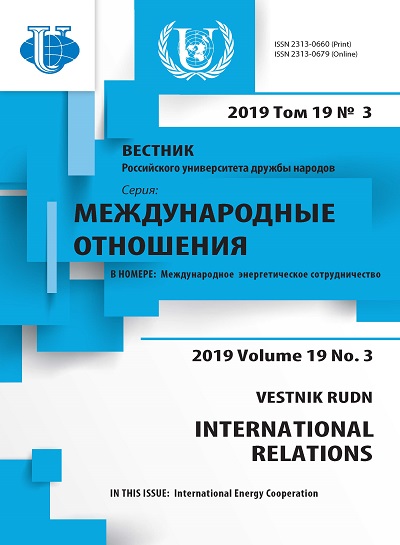Myths and Reality of “Lone Wolf” Terrorism in the Context of Islamist Extremism
- Authors: Yashlavskii A.E.1
-
Affiliations:
- Primakov National Research Institute of World Economy and International Relations, Russian Academy of Sciences
- Issue: Vol 19, No 4 (2019): Islamic Factor in World Politics
- Pages: 632-642
- Section: PEACE AND SECURITY
- URL: https://journals.rudn.ru/international-relations/article/view/22842
- DOI: https://doi.org/10.22363/2313-0660-2019-19-4-632-642
Cite item
Full Text
Abstract
The article analyzes the peculiarities of the terrorism of “lone actors”, acting under the influence of militant Islamist ideology. Although the potential of lone actors does not look so impressive compared to large terrorist groups, “lone wolves” terrorists are not becoming less dangerous. The danger of the phenomenon is due to the particular difficulty of preventing terrorist acts carried out by lone terrorists. At the same time, existing terrorist groups (e.g. ISIS), on the one hand, use the actions of lone terrorists for their propaganda purposes, and, on the other, try to inspire potential like-minded people to act alone. Thus, the actions of lone terrorists are included in the wider context of the extremist movement (“global jihad”). The article concludes that countering this threat is not only necessary, but possible. But this struggle requires both flexibility and responsibility.
About the authors
Andrei Eduardovich Yashlavskii
Primakov National Research Institute of World Economy and International Relations, Russian Academy of Sciences
Author for correspondence.
Email: dosier@mail.ru
PhD in Politics, Senior Researcher
Moscow, Russian FederationReferences
- Bennet, B.P. (2007). Understanding, Assessing, and Responding to Terrorism: Protecting Critical Infrastructure and Personnel. New York: Wiley-Interscience.
- Brynielsson, J., Horndahl, A., Johansson, F., Kaati, L., Martenson, Ch. & Svenson, P. (2012). Analysis of Weak Signals for Detecting Lone Wolf Terrorists. Swedish Defence Research Agency (FOI). European Intelligence and Security Informatics Conference. URL: https://www.foi.se/download/18.7fd35d7f166c56ebe0bffc0/1542623690297/Analysisof-weak-signals_FOI-S-4093-SE.pdf (accessed: 10.01.2019). doi: 10.1109/EISIC.2012.20
- Cafarella, J. & Zhou, J. (2017). ISIS’s Expanding Campaign in Europe. Institute for the Study of War. September 18. URL: http://www.understandingwar.org/sites/default/files/ISIS%20in%20Europe%20Update%20September-2017.pdf (accessed: 27.02.2018).
- De Roy van Zuijdewijn, J. & Bakker, E. (2016). Analysing Personal Characteristics of Lone-Actor Terrorists: Research Findings and Recommendations. Perspectives on Terrorism, 10 (2), 42—49.
- Ellis, C., Pantucci, R., de Roy van Zuijdewijn, J., Bakker, E., Smith, M., Gomis, B. et al. (2016). Analysing the Processes of Lone-Actor Terrorism: Research Findings. Perspectives on Terrorism, 10 (2), 33—41.
- Gill, P. (2015). Lone-Actors Terrorists: A Behavioral Analysis. London: Routledge.
- Glenn, J.C. & Gordon, T.J. (2014). 2013—14 State of Future. Washington: The Millennium Project.
- Global Terrorism Index 2017. (2017). Measuring and Understanding the Impact of Terrorism. Institute for Economics & Peace. November. URL: http://visionofhumanity.org/app/uploads/2017/11/Global-Terrorism-Index-2017.pdf (accessed: 30.01.2019).
- Global Terrorism Index 2018. (2018). Measuring the Impact of Terrorism. Institute for Economics & Peace. November. URL: http://visionofhumanity.org/app/uploads/2018/12/Global-Terrorism-Index-2018-1.pdf (accessed: 04.02.2019).
- Hofmann, D. (2018). How “Alone” are Lone-Actors? Exploring the Ideological, Signaling, and Support Networks of LoneActor Terrorists. The Canadian Network for Research on Terrorism, Security, and Society (TSAS). Working Paper Series. Winter, 18-02. URL: http://www.tsas.ca/wp-content/uploads/2018/02/TSAS-Working-Paper-Hofmann-LoneActors-Final.pdf (accessed: 10.01.2019).
- Kagan, F.W., Kagan, K., Cafarella, J., Gambhir, H. & Zimmerman, K. (2016). Al Qaeda and ISIS: Existential Threats to the U.S. and Europe. Institute for the Study of War. January. URL: http://www.understandingwar.org/sites/default/ files/PLANEX%20Report%201%20--%20FINALFINALFINAL.pdf (accessed: 10.01.2019).
- Kaplan, J., Loow, H. & Malkki, L. (Eds.). (2015). Lone Wolf and Autonomous Cell Terrorism. London: Routledge.
- Novikova, O.N. (2017a). “Lone Wolves” Terrorism. Actual Problems of Europe, 4, 188—207. (In Russian).
- Novikova, O.N. (2017b). One Person Army. European Security: Developments, Evaluation, Prognosis, 45 (61), 12—15. (In Russian).
- Schori Liang, Ch. (2017). Leaderless Jihad in a Leaderless World: The Future of Terror. In: Global Terrorism Index 2017. Measuring and Understanding the Impact of Terrorism. Institute for Economics & Peace. November, 88—91. URL: http://visionofhumanity.org/app/uploads/2017/11/Global-Terrorism-Index-2017.pdf (accessed: 30.01.2019).
- Simon, J.D. (2013). Lone Wolf Terrorism: Understanding the Growing Threat. NY: Prometheus Books.
- Solovyev, E.G. (2006). Transformation of Terrorist Organizations in the Globalization Context. Moscow: LENAND publ. (In Russian).
- Spaaij, R. & Hamm, M.S. (2015). Key Issues and Research Agendas in Lone-wolf Terrorism. Studies in Conflict and Terrorism, 38 (3), 167—178.
- Spaaij, R. (2012). Understanding Lone Wolf: Global Patterns, Motivations and Prevention. Dordrecht: Springer Verlag.
- Teich, S. (2013). Trends and Developments in Lone Wolf Terrorism in the Western World: An Analysis of Terrorist Attacks and Attempted Attacks by Islamic Extremists. International Institute for Counter-Terrorism. October. URL: https://www.ict.org.il/Article/691/Trends%20and%20Developments%20in%20L#gsc.tab=0 (accessed: 20.01.2019).











